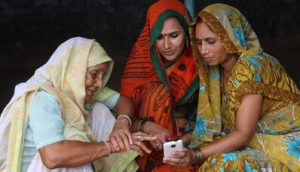Indian Women Are Exercising More Agency But Urban-Rural Gaps Persist

Indian women are exercising more agency as they participate more in decision making within their households, own and operate bank accounts and mobile phones, and own a land or a house than in 2015, according to the latest data from the second phase of National Family Health Survey – 5 released in November, 2021. This experience is not uniform as the gap between urban and rural women’s agency is stark. More urban than rural women participate in household decision making and use mobile phones, internet and bank accounts but NFHS-5 data show that more rural Indian women own any kind of property.
BehanBox had previously analysed data released by the government of India from the NFHS – 5, for 21 states and union territories in December 2020, to understand how rural and urban women in India exercise their agency. The data is based on four indicators in the survey – 1. women who participate in three household decisions 2. women owning a house and /or land (alone or jointly with others) 3. women having a bank or savings account that they themselves use 4. women having a mobile phone that they themselves use.
In continuation of the series, we will look at the findings on these indicators from across India with the new data released by the government of India on 24 November, 2021.
Deep Digital Divide
Only one-third women (33.3%) as opposed to more than half of the men (57.1%) have ever accessed the internet in India, according to NFHS-5 data, pointing to the gnawing digital divide. That gap grows starker between urban and rural women.
More than half of urban women (51.8%) have accessed the internet, while only a quarter (24.6%) of rural women have done so. With broadband penetration in rural India being only 29.2%, women in rural India are at a greater disadvantage. Their usage of the internet is monitored and regulated by members of the community, according to the narratives shared in this paper by Renza Iqbal. This gatekeeping is due to the patriarchal notion of honour, which includes the fear of women engaging in romantic relationships, or their photos being misused/ morphed onto pornographic material among others.
The urban-rural divide was highest in the states of West Bengal, Mizoram, Jharkhand, and Himachal Pradesh, and narrowest in Kerala and Goa.
In contrast, more women residing in rural areas (69.2%) than in urban areas (63.7%) had accessed the internet in Delhi.
Sikkim had the highest proportion of women who had ever accessed the internet at 78.7%, followed by Chandigarh at 75.2%, and Goa at 73.7%.
While the pandemic has increased digital adoption in India, it has also widened the existing gender digital divide. In 2020, men were 15% more likely to own a mobile phone in India and 33% more likely to use the internet as compared to women, according to the Mobile Gender Gap Report, 2021. Only 25% of Indian women reported owning a smartphone as opposed to 41% men, and 30% of Indian women reported using mobile internet in contrast to 45% men. The awareness of mobile internet, irrespective of usage, was also found to be higher among men – only 53% women as opposed to 69% men knew about mobile internet.
According to the report, the top barriers to internet usage among women are the lack of digital literacy and the affordability of mobile phones and data costs.
Several studies have also shown that the pandemic has negatively impacted education of girls. Almost 10 million secondary school girls faced the possible risk of dropping out of education due to the COVID-19 pandemic and the gap in digital access according to a policy brief released by Right to Education Forum, a platform of national education networks, teachers’ unions, and peoples’ movements that work towards making education accessible for all.
More women Own And Use Mobile Phones
More women now own a mobile phone and use it themselves than they did in the 2015-16 round of NFHS-4. More than half (54%) women operated their own phones — up from 45.9% in NFHS-4. Once again, the urban-rural divide is palpable.
69.4% women in urban India were owners of a mobile phone while 46.6% rural women could do so. Fewer women in Chandigarh (70%) own mobile phones in the latest data than in the previous round in 2015-16 ( 74.2%) .
91.2% women in Goa, 88.6% in Sikkim and 82.9% in Puducherry owned mobile phones, making them the top states.
Increased Agency Within Households
NFHS considers women as participants of the decision-making process if they are able to make decisions (alone or jointly with their husband) about three aspects — their own healthcare, major household purchases, and visits to the woman’s family or relatives.
According to the latest round of NFHS data, 88.7% women in India are now able to exercise influence in decision-making within households as compared to 84% women in 2015. 91% women in urban India reported enjoying greater agency in contrast to 87.7% of their rural counterparts.
Rural women in 13 states and UTs, including Delhi, Odisha, Tamil Nadu, Sikkim, Nagaland, Manipur, Kerala, Himachal Pradesh, Jammu and Kashmir, Goa, Bihar, Andhra Pradesh, and Andaman and Nicobar, enjoyed greater agency in decision making than their urban counterparts according to the NFHS-5 data.
Additionally, fewer women in Chandigarh, Arunachal Pradesh, Goa, Jammu and Kashmir, Ladakh, Manipur, Sikkim, Tripura, and West Bengal participated in household decision making, than they did previously as reported in the 2015-16 round of NFHS.
Data from NFHS-4 shows that older women are more likely to have a say in all three decisions compared to the younger ones. 69% among women aged 40-49 as compared to 46% among women aged 15-19 are able to make decisions in their households. More women in salaried employment have greater agency within their households. 70% of salaried women enjoy greater agency than unemployed women (62%) or women who are in unpaid employment (57%).
While data disaggregated by age, schooling and employment status for states surveyed in second phase of NFHS-5 is yet to be released, data from the first phase suggests a similar trend with participation increasing with age and employment status. However, the level of education seemed to have little to no effect on women’s autonomy or participation in household decisions.
Land and Property Ownership
An overall increase was observed in women’s ownership (alone or jointly with others) of land and property in India, with 43.3% women reporting ownership in the latest round as compared to 38.4% in NFHS-4 (2015-16). However, 16 out of 36 surveyed states and union territories reported a reduction in the percentage of women owning land or property as compared to the previous round.
Delhi, Madhya Pradesh, Odisha, Puducherry, Assam, Bihar, Goa, Kerala, Lakshadweep, Maharashtra, Meghalaya, Nagaland, Tripura, West Bengal and Uttarakhand are among the states and UTs that reported a drop in land or property ownership of women. The sharpest decline was observed in Tripura where 17.2% women reported ownership of property in the latest round as compared to 57.3% women in NFHS – 4.
Punjab demonstrates a discernible increase in percentage of women property owners — from 32.1% in 2015 to 63.5% in the latest round of the survey.
Arunachal Pradesh has the highest proportion of women owning land and property among all the states and union territories. 70.2% women — 70.3% women in rural areas and 69.8% women in urban areas — own land or property.
More women in rural than urban India are owners of land or property. The exceptions are Chhattisgarh, Lakshadweep, West Bengal and Sikkim – where more urban women own land or property as compared to rural women.
Studies have shown that property ownership has a positive impact on women’s bargaining positions within households, as well as their economic and nutritional well-being.
However NFHS figures on women’s ownership of land or property ownership can be misleading, claims Bina Agarwal, Professor of Development Economics and Environment at the University of Manchester. In her paper, she explains that the survey interviews only 15% of sample households, women in the 15-49 years age group and men in the 15-54 years age group. Further, it includes all lands and does not separate agricultural land from others.
Agarwal also claims in her paper, that NFHS data on land ownership presents inflated figures that are almost four times higher than the estimates presented by the India Human Development Survey – II, the second round of a multi-topic panel survey of 41,554 households in 1503 villages and 971 urban neighborhoods across India.
More women own and operate bank accounts
More than three-fourths (78.6%) of women in India report owning a bank account that they themselves used, as compared to 53% in NFHS – 4.
All states and UTs surveyed have shown an increase in the number of bank accounts owned and used by women except Lakshadweep, where 66.9% women own bank accounts in the latest round, compared to 74.4% in 2015-16.
The steepest rise is observed in Bihar where three times more women ( 76.7%) reported owning and operating a bank account in NFHS – 5 than in the 2015-16 round (26.4%).
More urban (80.9%) than rural (77.4%) women own bank accounts. In Delhi, Chhattisgarh, Jharkhand, Lakshadweep, Ladakh, Sikkim, Telangana, Goa, Dadra and Nagar Haveli and Daman and Diu, Andaman and Nicobar, Odisha, Puducherry and Punjab, rural women’s bank ownership accounts outnumbered those of urban women.
Puducherry has the highest percentage of women owning bank accounts at 92.6% followed by Tamil Nadu at 92.2%. At 55.8%, Dadar and Nagar Haveli and Daman and Diu have the least percentage of women owning bank accounts, according to NFHS-5 data.
Even as the number of women bank account owners have increased following the Pradhan Mantri Jan Dhan Yojna, 55% of women still don’t actively use their PMJDY accounts. According to studies, one of the major reasons for the existing financial gap is the low female labour force participation, most recently exacerbated by pandemic-related job loss.
We believe everyone deserves equal access to accurate news. Support from our readers enables us to keep our journalism open and free for everyone, all over the world.


